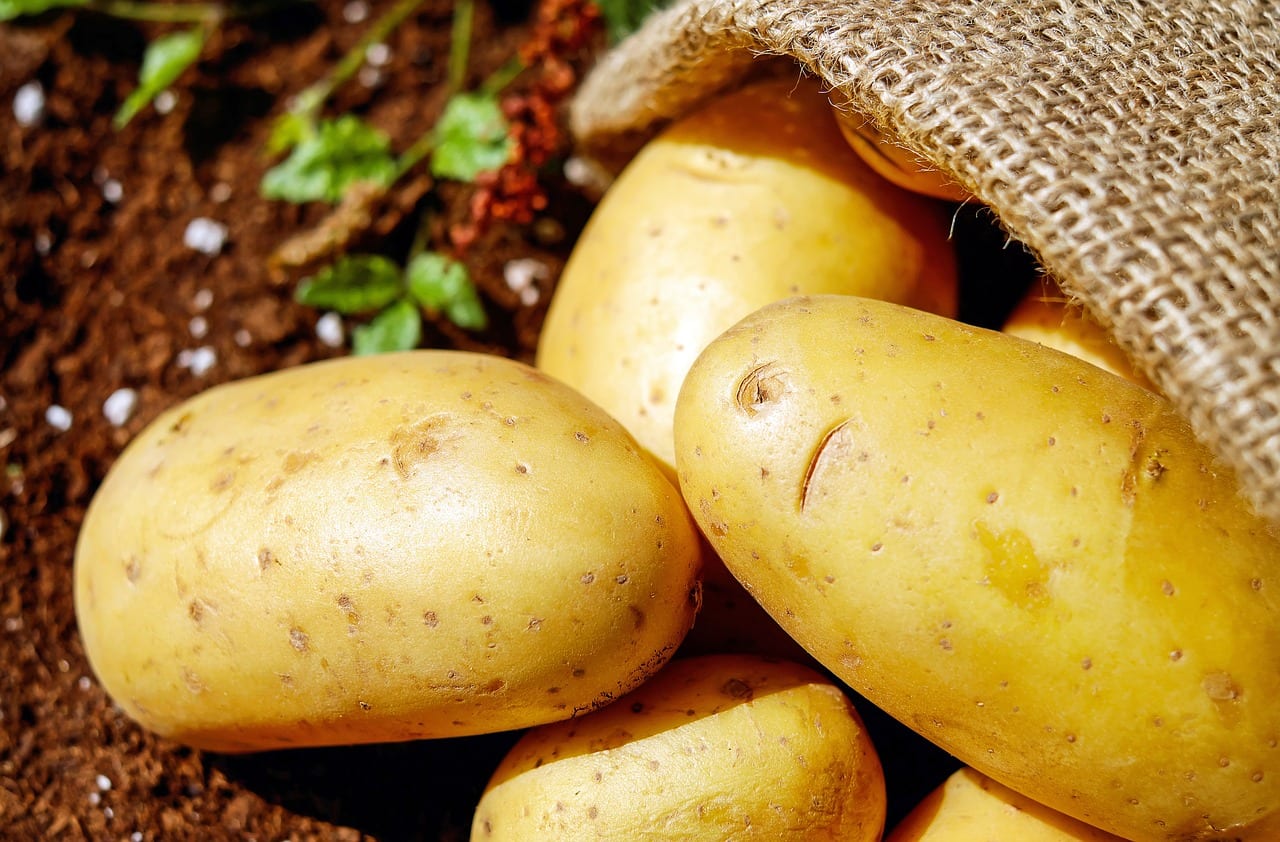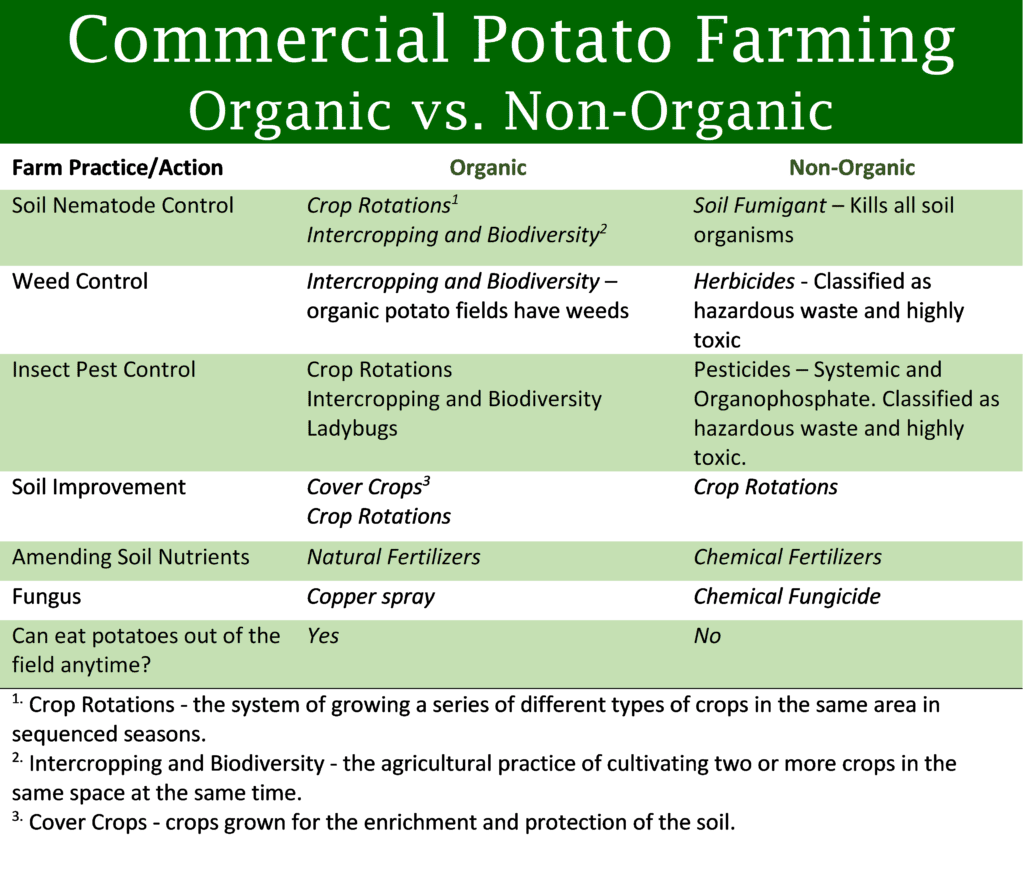
Commercial Potato Farming – Non-Organic Vs. Organic
Commercial Potato Farming is not an easy thing to do whether you’re doing it organically or non-organically. The non-organic potato farmer is pressured into producing a perfect, blemish-free tuber for the French fry market. To get this cosmetically perfect potato, these farmers have resorted to the heavy use of pesticides, herbicides, and fumigants. The result is a chemically-laden food product that isn’t safe to eat (in my opinion) and isn’t that nutritious.
It’s not easier for the organic potato farmer either. The organic farmer must know entomology, biology, botany, ecology, and in-depth knowledge of plant material. Both organic and non-organic farmers have the same challenges. To combat these challenges, the non-organic potato farmer uses chemicals and GMOs (Genetically Modified Organisms), and the organic potato farmer uses safe inputs, nature, and planned and built-in biological systems.
Let’s look at how non-organic and organic potatoes are grown.
Non-Organic Commercial Potato Farming
- Soil Fumigant (a gaseous pesticide)
The season starts off with a soil fumigant to control nematodes (micro-sized roundworm soil pests) and certain diseases in the soil. This fumigant is so strong it kills every trace of microbial life in the soil. When you’re working with dead soil, the nutrient density or nutrient value of the vegetable is very low. - Herbicide (kills plants)
Next, an herbicide is placed on the soil – Lexone, Sencor, or Eptam to clean the fields of all weeds. - Systemic Insecticide (absorbs into the plant)
At planting, a systemic insecticide, such as Thimet, is used. Systemic Insecticides are absorbed by the young seedling and will kill any insect that eats their leaves for several weeks. - Herbicide
When the potato plants are six inches tall, a second herbicide is sprayed on the field to control weeds. - Weekly Sprayings
A typical potato field receives 10 weekly sprayings of chemical fertilizer. - Fungicide (kills fungus)
Just before the leaves of one row start to touch the leaves of another row the field is sprayed with Bravo, a fungicide that controls late blight a deadly potato fungus. - Organophosphate Pesticide
The field is again sprayed with a crop duster, on fourteen-day intervals, to control aphids. Aphids can transmit leafroll virus, which causes a brown spot (a fungus that causes brown leaf spot), a cosmetic defect only. This pesticide is justified because consumers don’t want to see brown spots on their French fries. Some of the most toxic chemicals in use are used, such as an organophosphate pesticide called Monitor. Monitor is a deadly chemical. It is known to damage the human nervous system. A farmer or any two or four-legged creature is prohibited from going into a field that has been sprayed with Monitor for four or five days. - GMO Potato
If the farmer is using a GMO Potato, such as “NewLeaf,” by Monsanto, the above chemical applications can be cut in half. These GMO potatoes have a Bt gene that provides resistance to the Colorado Potato Beetle. Yes, these GMO Potatoes have in their genes a soil fungus called Bacillus thuringiensis, a soil-dwelling bacterium, commonly used as an organic biological pesticide. - Can you eat the Potatoes out of the field anytime?
No
Organic Commercial Potato Farming
- Crop Rotations
Long and complex crop rotations (growing different crop species in the same field) are used to prevent a buildup of crop-specific pests and disease. Typically potatoes see the same field once every five years. Planting Wheat, for example, after a season of potatoes “confuses” the potato beetles, which prevents pest build-up. - Intercropping and Biodiversity
Intercropping is the agricultural practice of cultivating two or more crops in the same space at the same time. Farmers may plant flowering crops on the margins of the potato fields such as peas or alfalfa, to attract the beneficial insects that eat beetle larvae and aphids. If there aren’t enough beneficial insects to do the job, ladybugs will be introduced. Organic potato farmers may grow up to eight varieties of potatoes together, to increase biodiversity in a field. Biodiversity in a field mimics natural systems and is the best protection against any pest and disease imbalances. This is also insurance against a bad year with one variety as it will possibly be offset by a better year with the others. - Natural Fertilizers
Natural fertilizers (compost and fish powder) are used. - Organic Fungicide
Copper spray is used. Copper spray is a safe organic fungicide. - Pest Control
Outside (brought from outside the farm) pest control inputs are ladybugs. - Can you eat the Potatoes out of the field anytime?
Yes


Which Potato Will You Eat?
It’s not even a choice for me now. Knowing how toxic the non-organic commercial potato farming is, I will only eat organic potatoes from now on. In one Michael Pollan blog article (Playing God in the Garden), Pollan quotes one non-organic farmer saying, “…I’m not sure I should be saying this, but I always plant a small area of potatoes without any chemicals. By the end of the season, my field potatoes are fine to eat, but any potatoes I pulled today are probably still full of systemics. I don’t eat them…”
If one non-organic potato farmer won’t eat his farmed potatoes… WHY SHOULD WE?
- Organic Lemons Are Great For Your Health
- Stock and Soup – Tastes Better When You Make Your Own
- Colcannon – Irish Potatoes and Kale
- Sausage and Pepper Hash – An Easy Sheet Pan Dinner
- Review Custom Harvest-Sarah D
- Roasted Root Vegetables
- Five Ways to Get Kids To Eat Vegetables
- Five Ways to Use Kohlrabi
- Strawberry Rosemary Wine Slushies – Beat The Heat
- Fuyu Persimmon – A Popular Harvest2U Organic Fruit
- 10 Ways to Help Your Kids Eat Healthier
- Chop and Drop – A Busy Person’s Best Friend
- Sweet Potato Stuffed with Avocado

Am Moses from kitale kenya, I grow potatoes, I like your Agriculture procedure of evaluation on how to grow and maintain the crop. Thanks a lot.
Thank you, Moses. We love growing potatoes here at Harvest2U farm organically.
A great potato presentation, much appreciated.
I wonder if you tried growing from the potato seed pods? They contain about 200+ seeds, and are easy to extract and hold over winter. I planted 25 of the seeds one year, but a little late. The growth was great but by fall they were still short a month or so of growth, because of my late planting.
Each seed produces a different type of potato, so I loved the result of seeing the huge difference in potato skin texture from smooth to semi rough, from almost white to almost russet, and size differences at each plant with 20+ potatoes of 1/2″ dia. on through 4 potatoes of +2″ length?
I wondered if using such seed pods would eliminate the transfer of chemicals, insecticides, herbicides and all other sides?
The internet shows how to recover the seeds from the pods and how to refrigerate and store. My age outgrew my enthusiasm somewhat.
Keep up the great work.